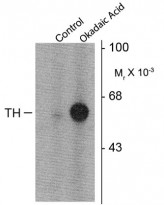ARG52463
anti-Tyrosine Hydroxylase phospho (Ser31) antibody
anti-Tyrosine Hydroxylase phospho (Ser31) antibody for ICC/IF,IHC-Formalin-fixed paraffin-embedded sections,Western blot and Mouse,Rat
Cancer antibody; Metabolism antibody; Neuroscience antibody
Overview
| Product Description | Rabbit Polyclonal antibody recognizes Tyrosine Hydroxylase phospho (Ser31) |
|---|---|
| Tested Reactivity | Ms, Rat |
| Predict Reactivity | NHuPrm |
| Tested Application | ICC/IF, IHC-P, WB |
| Host | Rabbit |
| Clonality | Polyclonal |
| Isotype | IgG |
| Target Name | Tyrosine Hydroxylase |
| Antigen Species | Rat |
| Immunogen | Synthetic phospho-peptide corresponding to amino acid residues surrounding Ser31 conjugated to KLH |
| Conjugation | Un-conjugated |
| Alternate Names | DYT14; TYH; Tyrosine 3-monooxygenase; Tyrosine 3-hydroxylase; TH; DYT5b; EC 1.14.16.2 |
Application Instructions
| Application Suggestion |
|
||||||||
|---|---|---|---|---|---|---|---|---|---|
| Application Note | Specific for the ~60k tyrosine hydroxylase protein phosphorylated at Ser31. * The dilutions indicate recommended starting dilutions and the optimal dilutions or concentrations should be determined by the scientist. |
Properties
| Form | Liquid |
|---|---|
| Purification | Affinity Purified |
| Buffer | 10 mM HEPES (pH 7.5), 150 mM NaCl, 0.1 mg/ml BSA and 50% Glycerol |
| Stabilizer | 0.1 mg/ml BSA, 50% Glycerol |
| Storage Instruction | For continuous use, store undiluted antibody at 2-8°C for up to a week. For long-term storage, aliquot and store at -20°C. Storage in frost free freezers is not recommended. Avoid repeated freeze/thaw cycles. Suggest spin the vial prior to opening. The antibody solution should be gently mixed before use. |
| Note | For laboratory research only, not for drug, diagnostic or other use. |
Bioinformation
| Database Links | |
|---|---|
| Gene Symbol | TH |
| Gene Full Name | tyrosine hydroxylase |
| Background | Tyrosine hydroxylase (TH) is the rate-limiting enzyme in the synthesis of the catecholamines dopamine and norepinephrine. TH antibodies can therefore be used as markers for dopaminergic and noradrenergic neurons in a variety of applications including depression, schizophrenia, Parkinson’s disease and drug abuse (Kish et al., 2001; Zhu et al., 2000; Zhu et al., 1999). TH antibodies can also be used to explore basic mechanisms of dopamine and norepinephrine signaling (Witkovsky et al., 2000; Salvatore et al., 2001; Dunkley et al., 2004). The activity of TH is also regulated by phosphorylation (Haycock et al., 1982; Haycock et al., 1992; Jedynak et al., 2002). Phospho-specific antibodies for the phosphorylation sites on TH can be used to great effect in studying this regulation and in identifying the cells in which TH phosphorylation occurs. |
| Highlight | Related Antibody Duos and Panels: ARG30212 Phospho Tyrosine Hydroxylase Antibody Panel (Total, pS31, pS40) Related products: Tyrosine Hydroxylase antibodies; Tyrosine Hydroxylase Duos / Panels; Anti-Rabbit IgG secondary antibodies; Related news: Astrocyte-to-neuron conversion for Parkinson's disease treatment |
| Research Area | Cancer antibody; Metabolism antibody; Neuroscience antibody |
| Calculated MW | 59 kDa |
Images (1) Click the Picture to Zoom In
-
ARG52463 anti-Tyrosine Hydroxylase phospho (Ser31) antibody WB image
Western blot: PC-12 cells incubated in the absence (Control) and presence of okadaic acid (OA, 1 µM for 60 min) showing specific immunolabeling of the ~60 kDa TH phosphorylated at Ser31 stained with ARG52463 anti-Tyrosine Hydroxylase phospho (Ser31) antibody.






